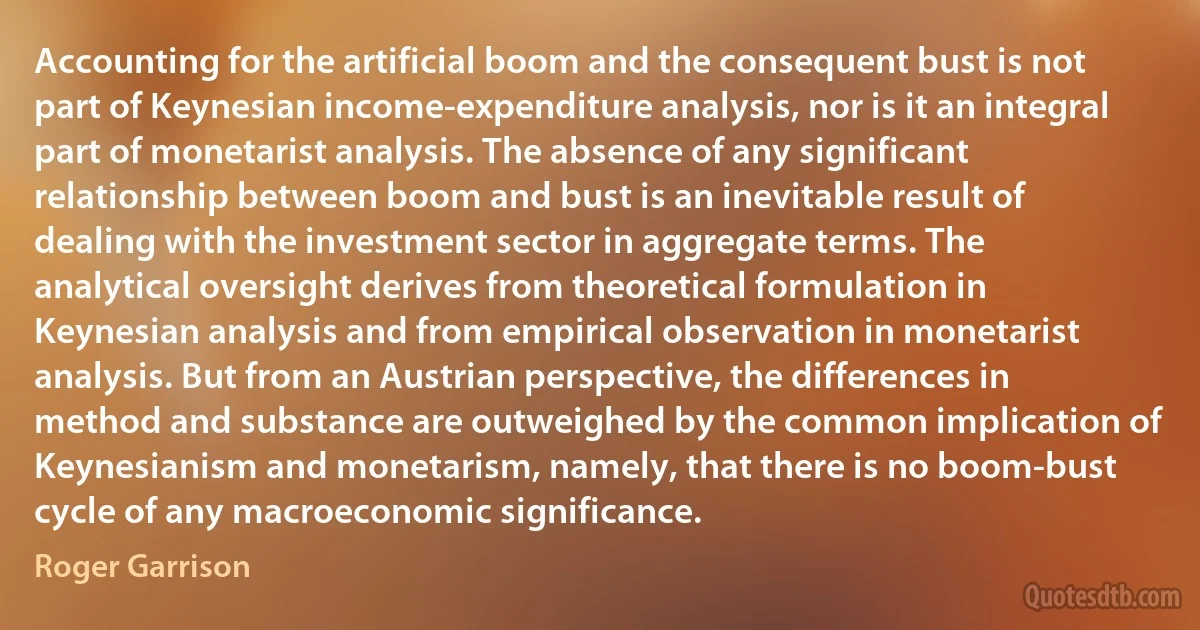
Accounting for the artificial boom and the consequent bust is not part of Keynesian income-expenditure analysis, nor is it an integral part of monetarist analysis. The absence of any significant relationship between boom and bust is an inevitable result of dealing with the investment sector in aggregate terms. The analytical oversight derives from theoretical formulation in Keynesian analysis and from empirical observation in monetarist analysis. But from an Austrian perspective, the differences in method and substance are outweighed by the common implication of Keynesianism and monetarism, namely, that there is no boom-bust cycle of any macroeconomic significance.
Roger GarrisonRelated topics
absence aggregate austrian common consequent cycle formulation implication integral nor oversight result sector significance significant keynesian keynesianism monetarismRelated quotes
How do wealth-income and capital-output ratios evolve in the long run, and why? Until recently it was difficult to properly address this question, for one simple reason: national accounts were mostly about flows, not stocks. Economists had at their disposal a large body of historical series on flows of output, income and consumption – but limited data on stocks of assets and liabilities. When needed, for example for growth accounting exercises, estimates of capital stocks were typically obtained by cumulating past flows of saving and investment. This is fine for some purposes, but severely limits the set of questions one can ask.

Thomas Piketty
Love of my home, my wife and my children./ Love for the earth that helps me live./ Love for education and of work./ Love of others who work for the common good./ Love of justice as the instrument that provides equilibrium for human dignity./ Love of peace in order to enjoy one's life./ Love of freedom, but not the freedom acquired at the expense of others' freedom, but rather the freedom of all./ Love of freedom to live and exist, for the existence of my children, in my home, in my town, my city, among neighbouring people./ Love for freedom in the environment in which we are required to forge our destiny./ Love of freedom without yokes: nor ours nor foreign.

Víctor Jara
Now, I should like to say something else to you about the connection with music, primarily that of Bach, i. e. the Fugue or, put more simply, the canon... It has a great deal in common with my own motifs, which I make turn on various axes too. Nowadays I have such a powerful sense of relationship, of affinity, that when I am listening to Bach I frequently get inspired and feel an overwhelming instinct for his insistent rhythm, a cadence seeking something of the infinite. In the Fugue everything is based on a single motif, often consisting of just a few notes. In my work, too, everything revolves around a single closed contour..

M. C. Escher
The basic law underlying all occult healing, may be stated to be as follows: Law I: All disease is the result of inhibited soul life, and that is true of all forms in all kingdoms. The art of the healer consists in releasing the soul, so that its life can flow through the aggregate of organisms which constitute any particular form. It is interesting to note that the attempt of the scientist to release the energy of the atom, is of the same general nature as the work of the esotericist when he endeavours to release the energy of the soul. In this release the nature of the true art of healing is hidden. Herein lies an occult hint.

Alice Bailey
Any effort, policy or program that has as a prerequisite the acceptance of the notion that blacks are inferior is a non-starter with me. I do not believe that kneeling is a position of strength. Nor do I believe that begging is an effective tactic. I am confident that the individual approach, not the group approach, is the better, more acceptable, more supportable and less dangerous one. This approach is also consistent with the underlying principles of this country and the guarantees of freedom through government by consent. I, like Frederick Douglass, believe that whites and blacks can live together and be blended into a common nationality.

Clarence Thomas
